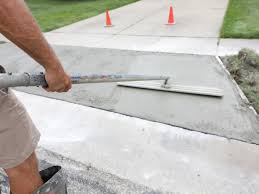Driveways are an essential part of your home’s exterior. Over time, wear and tear can cause unsightly cracks, which, if left untreated, may lead to more serious issues. Knowing when and how to repair your cracked driveway can save you money and keep your property looking its best. Here’s a comprehensive guide to help you identify the right time for repairs and steps to fix those problems effectively.
Understanding What Causes Driveway Cracks
Before jumping into repair methods, it’s important to know why cracks form in the first place. Common causes include:
Weather Changes
Extreme temperature shifts can cause the materials in your driveway to expand and contract, leading to cracks.
Poor Installation
If the surface were not installed properly, it might not withstand regular stress, making it prone to damage.
Heavy Load Stress
Frequent exposure to heavy vehicles or equipment can weaken the structure of your driveway.
Water Damage
Repeated exposure to water, especially from heavy rains or snowmelt, can erode the material underneath and create cracks.
Understanding these causes can help you prevent further damage and make better decisions when it’s time for repairs.
When Should You Repair Cracks?
The timing of repairs is crucial. Ignoring small issues can worsen the damage, leading to more extensive and costly solutions later. Here are some signs it’s time to act:
Small Surface Cracks
If you see thin cracks less than a quarter-inch wide, they can usually be repaired quickly with minimal effort. These are generally cosmetic but should still be filled to prevent further growth.
Widening or Spreading Cracks
When cracks expand over time, it’s a sign of underlying structural problems. Address these as soon as possible to avoid larger repairs.
Water Pooling
If water starts to collect in the cracks after rain, sealing them promptly can prevent long-term water damage to the base material.
Seasonal Changes
Fall is often the best time for repairs. The moderate weather allows sealants to set properly, ensuring long-lasting repairs. Avoid repairs during extreme heat or cold.
How to Repair Cracks in Your Driveway
Once you’ve identified a need for repairs, follow these steps based on the type and severity of the crack.
Step 1: Clean the Area
Start by removing dirt, debris, and vegetation from the crack. Use a broom, compressed air, or a pressure washer to ensure the area is clean and dry. Any remaining debris can interfere with the repair material’s adhesion, so this step is crucial.
Step 2: Assess the Damage
Evaluate the size and depth of the crack to determine the best repair method. For shallow cracks, surface fillers will suffice. However, deep or wide cracks may require extra reinforcement.
Read more : How to Analyze and Select Mutual Funds Using Financial Ratios
Step 3: Choose the Right Filler
Caulking or Liquid Filler
For small cracks, a ready-to-use liquid filler or caulk works best. These products are easy to apply and provide a smooth finish.
Crack Sealants
For medium-sized cracks, use a crack sealant. This flexible material prevents further expansion and seals the area effectively.
Patch Mix
For larger or deeper cracks, you may need a patching compound mixed with an aggregate. This creates a more durable solution to support heavier loads.
Step 4: Apply the Filler
Follow the instructions provided with the repair product. Typically, you’ll apply the material directly into the crack, spreading it evenly with a trowel or putty knife. Some products require multiple layers for proper coverage.
Step 5: Seal the Surface (Optional)
After the cracks are filled, consider sealing the entire driveway to protect against future damage. Sealing adds a layer of protection against weather, water, and UV exposure, enhancing the longevity of your repairs.
Preventing Cracks in the Future
Once your driveway is repaired, it’s essential to maintain it properly to avoid future issues. Consider these tips:
- Regular Cleaning: Keep your driveway clean by removing debris and weeds from cracks.
- Resealing: Apply a protective sealant every two to three years to prevent water seepage and wear.
- Steady Maintenance: Address any minor cracks or potholes as soon as they appear to avoid larger problems later.
- Proper Drainage: Ensure water drains away from your driveway, preventing pooling that can erode the material.
By following these steps, you can maintain a smooth and crack-free driveway for years to come, whether it’s asphalt or concrete.
When to Call a Professional
While small cracks are easy to manage with DIY solutions, extensive cracking, drainage issues, or structural damage may require professional help. For example, if you’re seeking assistance with asphalt crack repair in Salt Lake City or any other area, consulting an expert can ensure the job gets done right. Professionals have the tools and experience to handle larger problems effectively and save you from future hassle.
Final Thoughts
Repairing driveway cracks may seem like a daunting task, but with the right timing and techniques, it’s a manageable process. By addressing problems early, selecting the proper repair materials, and committing to regular maintenance, you’ll save money and keep your driveway in excellent condition. Don’t wait for minor problems to become major headaches—treat cracks as soon as you spot them.

